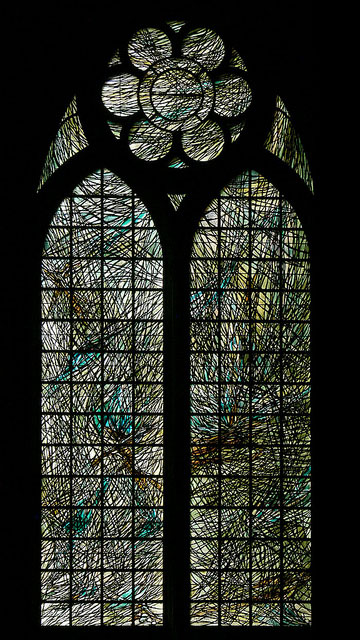Brigitte Simon-Marq

Born in 1926 into the long-established Simon family of Reims glassmakers, Brigitte Simon was the daughter of Jacques Simon (1890 – 1974), whose atelier was already renowned for its historic restorations and ecclesiastical commissions. She first trained and worked within her father’s studio, acquiring the traditional skills of glass painting, cutting, and leading that had defined the family craft since the seventeenth century.
After a period of study and artistic practice in Paris, Simon met and later married Charles Marq (1923-2006), a painter and glass artist with whom she shared a deep interest in the renewal of sacred art through modern design. Returning to Reims, the couple assumed the direction of the family firm in 1957, marking the beginning of a dynamic new phase in the workshop’s long history.
Under their joint leadership, the atelier, now known as Atelier Simon-Marq, became a centre of collaboration between craftsmen and leading twentieth-century artists. Working with figures such as Marc Chagall, Roger Bissière, and Joan Miró, Brigitte Simon and Charles Marq translated modern painting into the luminous medium of stained glass, uniting artistic innovation with technical precision. Their work included the celebrated Chagall windows for the cathedrals of Metz and Reims, projects that brought international recognition to both the artists and the atelier.
As both designer and craftsperson, Brigitte Simon embodied the union of artistry and tradition that characterises the best of post-war French stained glass. Her refined sense of colour, sensitivity to architectural light, and commitment to collaborative creation ensured the continuation of the Simon legacy into the contemporary era. Upon her death in 2009, the direction of the atelier passed to her son Benoît Marq, the twelfth generation of the family to uphold the Reims tradition.


Installed in 1961 in the south transept of Reims Cathedral, near the baptismal font, these three tall lancet windows by Brigitte Simon and Charles Marq marked a turning point in the visual language of sacred glass within a Gothic context. Created under the auspices of the historic Atelier Simon-Marq, the ensemble reflects the radical yet deeply spiritual aesthetic that the couple introduced to mid-twentieth-century ecclesiastical art.
The design abandons traditional figurative representation in favour of an abstract interplay of light, texture, and motion. Each panel is constructed from a dense network of interlaced linear motifs that suggest organic growth or flowing water, rendered in a palette of muted greens, golds, and silvers. The rhythmic web of lead and colour embodies both energy and stillness, an evocation of spiritual renewal appropriate to its placement near the font.
When first unveiled, the windows provoked considerable controversy among parishioners and visitors, many of whom felt that the modern idiom clashed with the thirteenth-century fabric of the cathedral. Yet the work was soon recognised for its sensitivity to the building’s medieval light and its capacity to bridge past and present. The artists’ subtle manipulation of translucency allows the Gothic stonework to remain dominant, while infusing the space with a living radiance that shifts with the daylight.
The Reims transept windows anticipate the collaborations with Marc Chagall that Brigitte Simon and Charles Marq would undertake a decade later for the cathedral’s axial chapel. In these earlier works, their approach is more austere but already reveals their distinctive philosophy, that sacred glass should be an environment of contemplation rather than a surface of narrative. The ensemble stands today as a pivotal moment in the post-war renewal of French stained glass, emblematic of the Simon-Marq workshop’s fusion of heritage craftsmanship and modern expression.


Installed between 1978 and 1981 in the north transept of Reims Cathedral, these monumental grisaille windows by Brigitte Simon and Charles Marq complete the aesthetic dialogue begun with their earlier south transept ensemble of 1961. While the earlier windows explore the vitality of light through colour and linear movement, these later works embody a meditation on purity, material, and the elemental nature of light itself.
Executed entirely in subtle tonal variations of white, grey, and silvered glass, the windows represent the elements of Fire, Earth, and Air, a triptych of creation rendered in abstraction. Their intricate network of engraved and leaded lines suggests shifting natural forms: flame, strata, wind, and water rendered as pure gesture. The treatment of the surface, alternating between transparency, texture, and reflection, allows the northern light to pass through with a quiet, ethereal luminosity, transforming the space into a sanctuary of calm radiance.
By the time of their installation, the controversy that had greeted Simon and Marq’s first modern windows in the cathedral had long subsided. The new grisailles were received with respect and even admiration, seen as harmonising modern sensibility with Gothic architecture through restraint and reverence. In these later works, the artists achieved a fusion of spiritual contemplation and architectural clarity, distilling their mature vision of sacred glass as an instrument of light rather than narrative.
The north transept grisailles stand as a testament to the enduring relationship between the Atelier Simon-Marq and Reims Cathedral, a collaboration spanning centuries, culminating in these late twentieth-century works that reaffirm the cathedral’s identity as both a monument of history and a living vessel of light.
